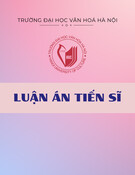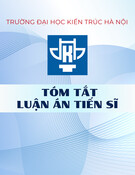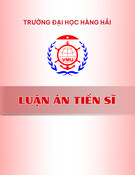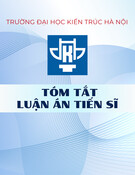
1
MINISTRY OF EDUCATION
VIETNAM ACADEMY
OF SCIENCE AND TECHNOLOGY
GRADUATE UNIVERSITY SCIENCE AND TECHNOLOGY
-----------------------------
VU VAN DUAN
Analyzing structure and function of landscape
for the orientation of rational use of the territory
of Ma river basin (the part belong to Thanh Hoa province)
Major: Physical Geography
Code: 9.44.02.17
SUMMARY OF GEOGRAPHY DOCTORAL DISSERTATION
HA NOI - 2020

2
The dissertation has been completed at: Graduate University Science
and Technology - Vietnam Academy of Science and Technology
Science advisor 1: Dr.Phil. Pham The Vinh
Science advisor 2: Assoc. Prof, Dr.Sc. Nguyen Van Cu
Reviewer 1: …………………………………………………..
Reviewer 2: …………………………………………………..
Reviewer 3: …………………………………………………..
The thesis will be defended in Doctoral Committee, organized at: - Location:
Graduate University Science and Technology -Vietnam Academy of Science and
Technology - Time:
The dissertation can be found at:
- Library of Graduate University Science and Technology
- National Library of Vietnam

1
INTRODUCTION
1. The urgency of the study
Reasonable use of territory means effective use of natural and socio-economic
resources, suitable to the inherent potential of the territory, ensuring socio-economic
development and environmental protection in a sustainable manner. There have been
many views and approaches to solve this problem, including the views and
approaches of Geography. From the perspective of general physical geography, in
order to establish the scientific basis for solving the above problem, we must first
grasp the laws of territorial division by research and analysis of landscape structure
and function on the territory. Study landscape structure including vertical structure,
horizontal structure and dynamic structure. By analyzing landscape structure, it is
possible to identify the natural and socio-economic potentials, thereby defining the
functions of landscape units to propose solutions for rational use of territory.
Although there have been many studies that analyze landscape structure and
function on different territorial scales, the resear in this direction applied on the river
basin are still relatively few in number. Therefore, many theoretical and
methodological issues need to be resolved to draw from the researches. For example,
is there any difference between the classification and zoning landscape system along
river basin and the classification and zoning landscape system by administrative
units, what is the difference of the viewpoint of rational use of territory by river
basin, to add to the theory as well as methods of landscape research according to the
theory of "closed geographical system".
The Ma river basin in Thanh Hoa province is a transnational basin, with about
two thirds of the basin belongs to the Lao People's Democratic Republic. The Ma
river basin part in Thanh Hoa province is located from 19o18’N to 20o40’N and from
104o22’E to 106o04’E, with the area of 1.061.000 ha, accounts for 1/3 of the total
natural area of Ma river basis and above 95% of the natural area of Thanh Hoa
province, bordering the Gulf of Tonkin with the length of about 102 km. In such a
geographic location, the Ma river basin of Thanh Hoa province has a transitional
climate between Northern and Central Vietnam. It is also a place of exchange of
migratory flows of plants and animals in the world with native plants and animals.
With specific natural conditions, the research territory has abundant natural resources
that facilitate the development of various economic activity, especially in the field of
agriculture and forestry.
Although there is great potential, the actual production has not matched the
potential, agricultural and forestry production activities still have many
shortcomings. In addition, there have been problems such as floods, droughts, slides,
landslides, degraded resources, etc. There are many reasons for this situation, but the
main reason is that due to the lack of scientific data, the management, exploitation
and use of natural resources for economic development in general, agriculture and
forestry in particular still remain drawbacks and are not commensurate with the
potential. Especially in planning sectors only pay attention to the interests of each
sector but not to the overall benefits, leading to conflicts and waste in using
resources. Not yet fully promoting comparative advantages of the research territory.

2
Therefore, in view of the analysis of landscape structure and function, it will
reconcile the internal contradictions of the territory, also provides an overview of the
potential of natural conditions and resources; from that, we can find the natural law
and promote the strengths and potentials of the Ma river basin.
From theoretical as well as practical issues, the researcher choose the topic
“Analyzing structure and function of landscape for the orientation of rational use
of the territory of Ma river basin (the part belong to Thanh Hoa province); hoping
that it will contribute a small part in the scientific basis for the rational use of natural
resources and environmental protection of the research territory.
2. Aim and research mission
2.1. Aim
- Clarifying structural features, functions and differentiation of landscape thereby
determines the law of in Ma river basin, Thanh Hoa province.
- Establishing a scientific basis for rational use of landscape units for agricultural
and forestry development purposes, contributing to the orientation of rational use of
the territory of the Ma river basin in Thanh Hoa province.
2.2. Mission
- Overview of literature on the study of landscape structure and function and
landscape research along river basins. Collecting, analyzing and systematizing
document on the natural and socio-economic conditions of the research territory.
- Studying the components of landscape formation and the relationship of the
components to the formation of landscape units.
- Establishing a landscape map, landscape zoning map, rational land use
orientation map for agriculture and forestry development at the ratio of 1:100.000 for
the whole basin, to reflect the territorial division rule. Analyzing the relationship
between landscape structure and landscape function, thereby establishing a scientific
basis for the development of economic sectors in the research territory.
- Proposing orientations for rational use of the territory of Ma river basin, Thanh
Hoa province.
3. Scope of the study
3.1. Spatial limitation
The land area of Ma river basin in Thanh Hoa province is 1,061,000 ha.
3.2. Scientific limitation
- Approaching to theory of structural and functional landscape analysis according
to river basins.
- Limiting the scope of rational use of the territory of the Ma River basin in
Thanh Hoa province for the development of agro-forestry economy (food crops
group; fruit tree group; annual industrial crops group; forestry includes: production
forests and protection forests).
4. Protected points
- The diversity of structure and functions of landscape of the Ma river basin in
Thanh Hoa province is a combined result of the differentiation and interaction among
the landscape forming components that created the system of landscape units with
rich and diverse natural potential.

3
- The results of analyzing the landscape structure and functions as well as the
current status of territorial exploitation and socio-economic development orientation
to 2020 and a vision to 2030 are the scientific basic for proposing the development
orientation of agriculture and forestry in Ma river basin, Thanh Hoa province.
5. The new points of the thesis
- Building up a typical classification system and landscape map at the ratio of 1:
100,000 and analyzing the landscape structure and functions of Ma river basin in
Thanh Hoa province
- Assessing landscape and development orientation of agriculture and forestry
according to landscape and sub-region landscape of Ma river basin in Thanh Hoa
province.
6. Scientific and practical significance
6.1. Scientidic significance
- The results of the study clarify the law of landscape differentiation and the
diversity and division of landscape units in the monsoon tropical conditions of
Vietnam in general, and natural division in Ma river basin in particular.
- Contributing to complete the theoretical basis of structure and function
landscape analysis according to river basins for the rational use of territory.
6.2. Practical significance
- Proposing the rational use of the territory of Ma river basin in Thanh Hoa
province.
7. Document basis
- Database of base maps and thematic maps: topographic maps, geological maps,
maps of current status and planning of forests, maps of soil and status quo of land
use.
- Studies, projects, scientific reports on the investigation of natural conditions,
natural resources and environment. Statistical yearbook of Thanh Hoa province for
the period 2010-2016.
- 01 research at the University level of the author related to thesis.
- Recordings, observations, analyses, photographs and films by the author from
field trips from 2014 to present.
8. Structure of the thesis
The dissertation is presented in writing. In addition to the introduction and
conclusion, references and appendix; the thesis content was presented into 3 chapters,
with 141 typed pages in A4 size, 37 pictures (including charts, maps, diagrams), 54
tables of data, 12 published works of the researcher related to the dissertation and list
of 84 references in Vietnamese and foreign languages.

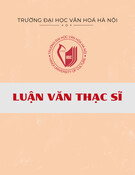





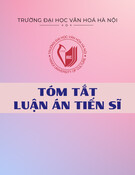
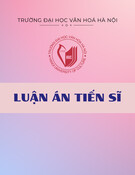
![Phát hiện và nhận dạng tiếng Việt trong ảnh CCCD, ảnh ngoại cảnh: Nghiên cứu phương pháp nâng cao độ chính xác [Luận án Tiến sĩ]](https://cdn.tailieu.vn/images/document/thumbnail/2025/20250807/vijiraiya/135x160/7691754555235.jpg)
